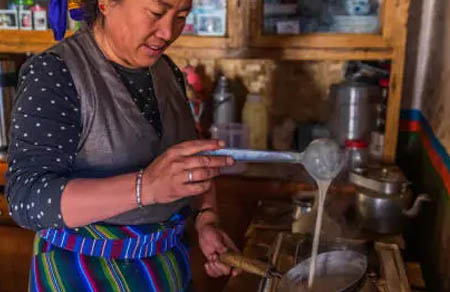
Nepal’s Churpi Exports Reach New Heights: A Deep Dive into the Thriving Industry
December 20, 2024Nepal’s churpi industry is making remarkable strides in the international market, with exports reaching an impressive Rs 1.15 billion in the first four months of the current fiscal year. This achievement highlights the growing global demand for this traditional Himalayan product, often referred to as one of the hardest cheeses in the world.
Export Figures and Market Dynamics
In the first four months, Nepal exported 621,747 kg of churpi to countries across the globe. The United States emerged as the dominant market, accounting for approximately 90% of total exports. Specifically, 552,048 kg of churpi worth Rs 1.22 billion were shipped to the US alone. Canada followed as the second-largest importer, with 32,405 kg valued at Rs 77.297 million.
The list of export destinations extends beyond North America, including Brazil, China, Greece, Japan, South Korea, Malaysia, Singapore, the United Kingdom, and Ukraine. Despite this diversification, the US remains the most lucrative market, reflecting its insatiable demand for churpi, primarily as a pet chew product.
Challenges in Domestic and Cross-Border Trade
While churpi exports flourish internationally, challenges persist in the domestic and neighboring markets. Rajkumar Dahal, President of the Nepal Dairy Industry Association, notes that although much of the churpi produced in eastern Nepal flows into India, it often bypasses formal trade channels due to the open border. This lack of regulation prevents Nepali brands from capitalizing on their own products in the Indian market.
Infrastructure limitations and a lack of standardized production methods further complicate the situation. Most churpi is still produced traditionally in households, particularly in regions like Sindhupalchok, Panchthar and Ilam. While exporters collect and modify the product for global markets, the absence of large-scale, systematic production facilities limits scalability.
Rising Global Demand and Production Trends
The international appetite for churpi, especially as a dog chew, has spurred an increase in production. Entrepreneurs like Krishna Dangal of Rajesh Dairy Industries Pvt. Ltd. from Sindhupalchok-Chautara have ramped up efforts to meet demand. Rajesh Dairy exports approximately 10,000 kg of churpi monthly, sourcing from both his own production and local dairies.
“The market for churpi is excellent, but quality production and supply remain a challenge,” Dangal said. He emphasized that 20 to 22 liters of milk are required to produce just 1 kg of churpi, making it a labor-intensive process that also benefits local farmers.
Historical Export Performance
Data from the Department of Customs reveals a consistent upward trajectory in churpi exports over the years. In fiscal year 2076/77, Nepal exported 717,264 kg worth Rs 1.228 billion, with the US receiving 624,353 kg. By 2079/80, exports had surged to 1.786 billion kg valued at Rs 3.49 billion, underscoring the industry's rapid growth.
Government and Industry Initiatives
Recognizing the potential of the churpi industry, the Dairy Development Corporation (DDC) has taken steps to support its expansion. Recently, DDC signed an agreement with Manram Himalayan Handicraft Pvt. Ltd. to supply 10,000 liters of milk daily for churpi production. This initiative aims to create a market worth Rs 700,000 daily and reduce surplus stock in DDC’s warehouses.
Future Prospects
The churpi industry’s success highlights its potential as a cornerstone of Nepal’s agricultural export sector. With increasing global demand, particularly from the US and Canada, and efforts to formalize production and quality standards, the industry is poised for sustained growth. Investments in infrastructure, technology, and branding could further elevate Nepal’s standing as a leading exporter of this unique Himalayan delicacy.
As international markets continue to embrace churpi, the industry not only contributes significantly to Nepal’s economy but also preserves a traditional craft deeply rooted in Himalayan culture.
Nepalese Chhurpi: A Himalayan Treasure Gaining Global Recognition
What is Chhurpi?
Chhurpi, also called durkha or chogo, is a traditional Himalayan cheese originating from Nepal and Bhutan. Famous for being one of the hardest cheeses in the world, it comes in two types: soft chhurpi, used in cooking, and hard chhurpi, known for its unique chewy texture. This nutrient-dense cheese has been a dietary staple for Himalayan mountain communities for centuries.
How is Chhurpi Prepared?
The art of preparing chhurpi reflects the culinary traditions of the Himalayan region. It’s crafted from the milk of yaks, cows, or chauri (a yak-cow hybrid). After boiling buttermilk, the curdled solids are collected, pressed, and then sun-dried or smoked for the hard variety, while the soft variety is left fresh for immediate use. This traditional method ensures chhurpi’s distinctive taste and quality.
Why is Chhurpi So Healthy?
Chhurpi is a superfood with high protein content, Omega-3 fatty acids, and antioxidants, particularly when made from yak milk. It’s an excellent energy source for those living in harsh climates. Additionally, its hard texture helps improve dental health by removing plaque and strengthening gums.
Creative Culinary Uses of Chhurpi
Soft chhurpi is a versatile ingredient, often used in soups, stir-fries, and momo (dumpling) fillings. It can also be blended with tomatoes and chilies to make delicious chutneys. Hard chhurpi is a favorite on-the-go snack, chewed for hours like natural chewing gum, offering both flavor and activity.
Where to Buy Chhurpi Dairy Products from Nepal?
Looking for high-quality chhurpi in bulk? Nepal Art Shop Export & Import Pvt. Ltd. offers competitive pricing, efficient manufacturing, and global export services. Contact them for wholesale inquiries:
- Email: nepalartshop@gmail.com
- Website: www.nepalartshop.com
- Contact Person: Sharama Meera
The Cultural and Economic Significance of Chhurpi
Chhurpi is more than just cheese; it’s a symbol of Himalayan culture. It serves as a source of income for farmers and pastoralists in Nepal, Bhutan, and India. In local traditions, chhurpi is a token of hospitality and a cherished gift during festivals and gatherings.
Chhurpi’s Incredible Longevity
One of the most unique features of hard chhurpi is its astonishing shelf life. When properly dried, it can last up to 20 years without spoiling, making it a staple food for long journeys or survival situations in remote mountain regions.
Chhurpi Substitutes and Global Availability
If authentic chhurpi isn’t accessible, hard cheeses like Parmesan or Pecorino can be used as substitutes in recipes. However, chhurpi’s chewy texture and smoky flavor are unmatched. Today, chhurpi is available in specialty stores and online, bringing the flavors of the Himalayas to global audiences.
Discover the Global Demand for Nepalese Churpi
Nepalese Churpi exports have reached unprecedented heights, earning over Rs 1.15 billion in just 4 months. With major markets in the US, Canada, and Europe, this nutrient-dense Himalayan delicacy is gaining global recognition. Stay informed about export trends, production insights, and how Nepalese farmers are driving this success story.
Subscribe for UpdatesJoin our community and explore how Nepalese traditions are shaping global markets.
Read More From Us
- 🌟🌟🌟🌟🌟 For more International Breaking News visit us at International News
- 🌟🌟🌟🌟 For More Russia-Ukraine War updates, click here
- 🌟🌟🌟🌟🌟 For more International Trade Business news, hit here
Tags: #NepaleseChurpi #HimalayanTraditions #GlobalExports #ChurpiCheese #NepalExports #CulturalDelicacy #SustainableFarming #HimalayanCheese #HealthyLiving #GlobalDemand #GlobalPostHeadline
Thank you for reading: globalpostheadline.com





